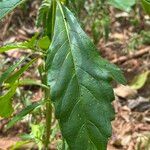An erect annual herb. It is like a small shrub. The leaves are opposite. The leaves have teeth around the edge. The flowers are small and blue. They occur in long spikes.
Flowers deep blue with white centre
A well-branched herb 2-3 ft. high
Very long narrow spikes
A weed.


